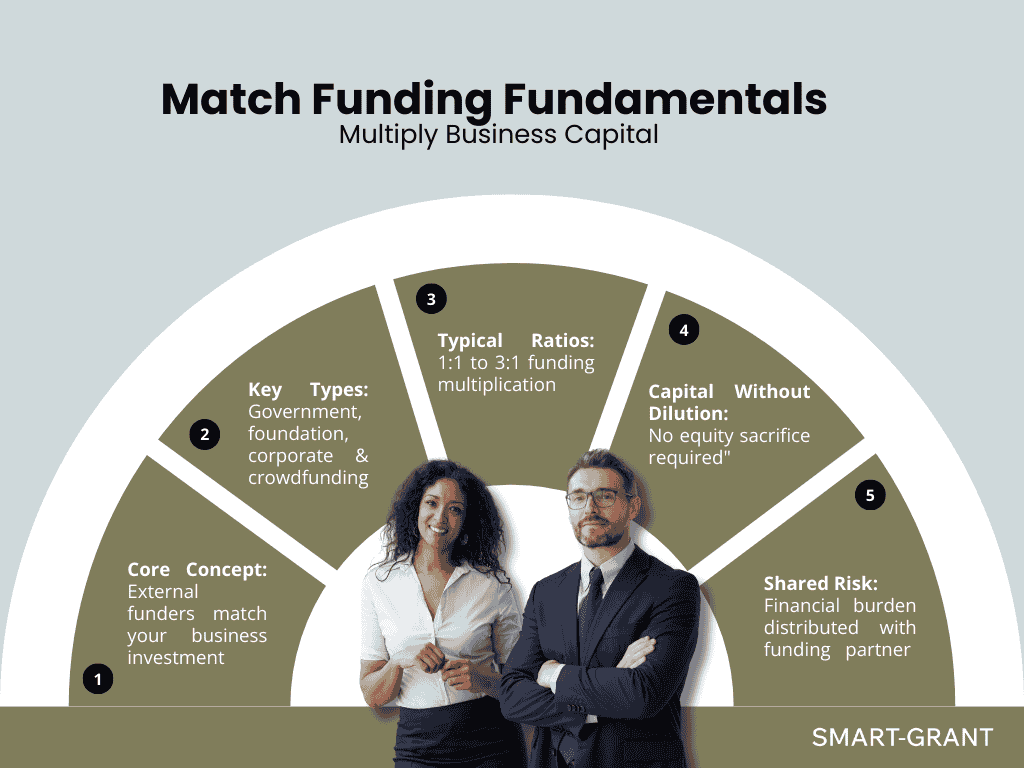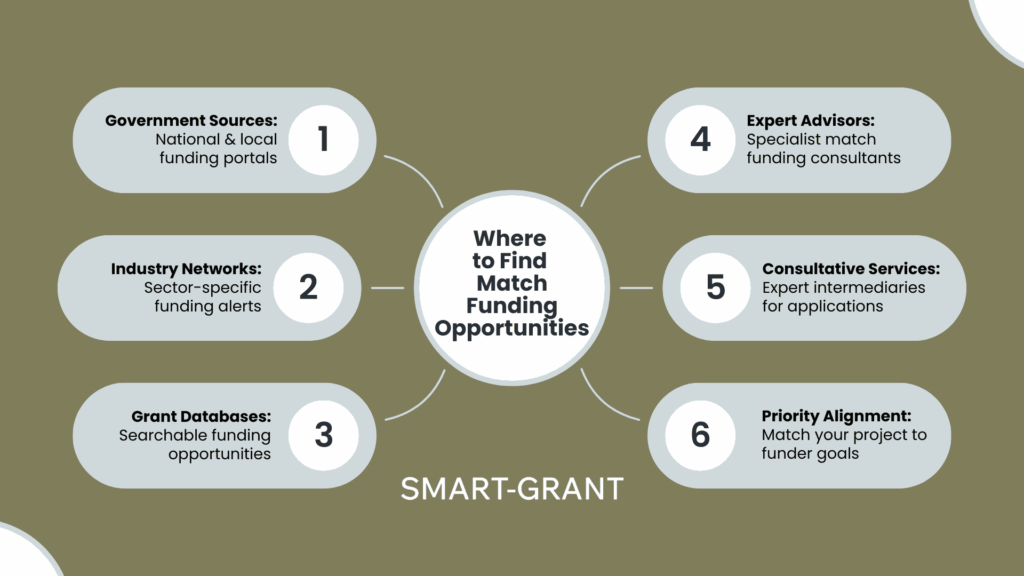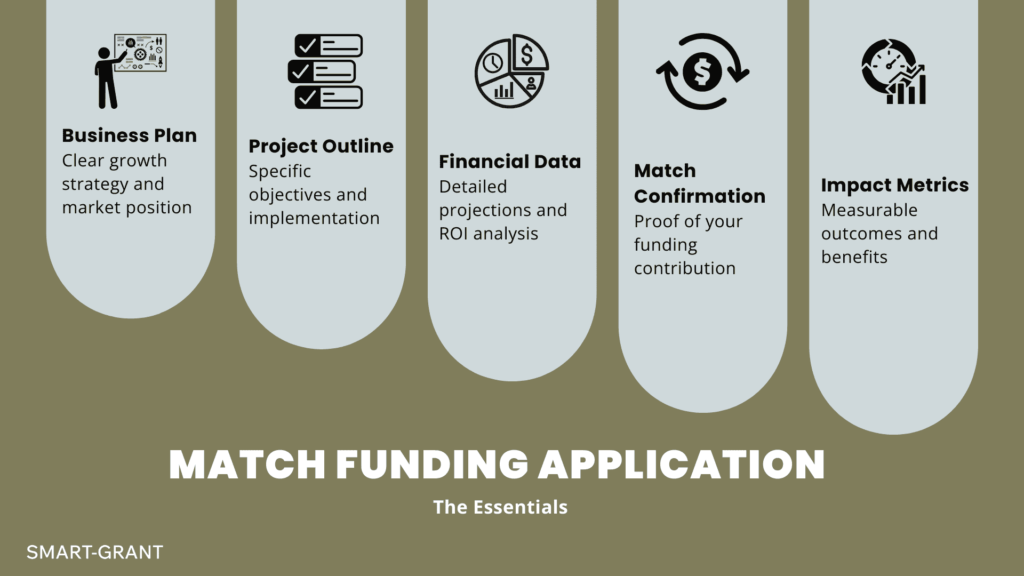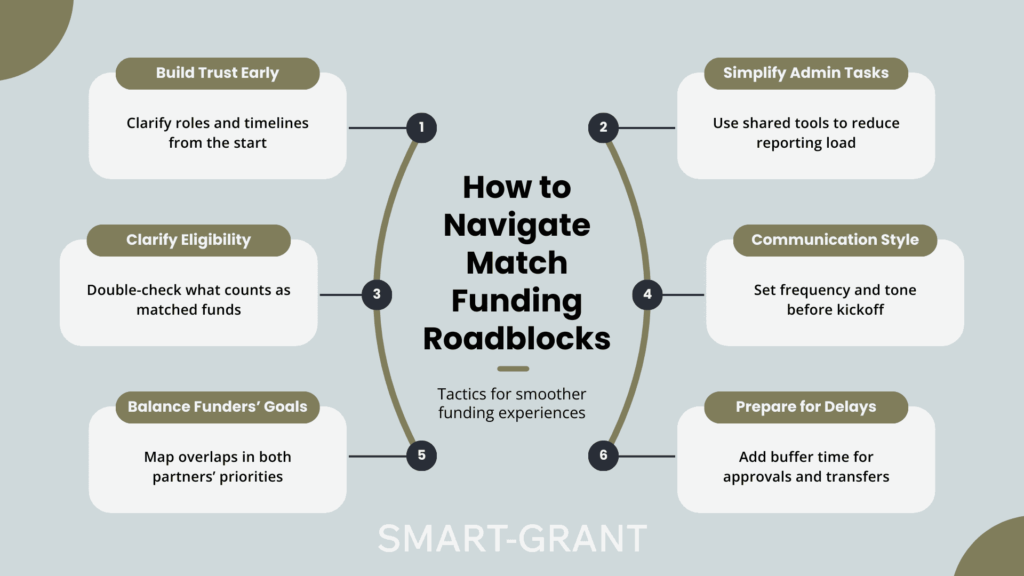Match funding forms a critical component of modern business finance strategies, particularly for small and medium businesses (SMBs) that are seeking to expand operations without sacrificing equity (Unlike dilutive funding).
This article provides a thorough examination of match funding structures, practical application tactics, and techniques to enhance your chances when chasing these funding avenues.
We’ll look at different match funding types, who qualifies, how to apply, and smart ways to land this crucial form of capital.
By the end, you’ll know how to exactly tackle match funding programs and decide if this financing route suits your business ambitions.

What Is Match Funding?
Match funding happens when an organization agrees to match money put in by another party, usually based on some agreed ratio.
For businesses (mostly SMBs), this typically means that for every pound or dollar you invest from your pocket, some external funding body gives you the same amount or a proportion of it. This funding approach works like a partnership between your business and the funding provider, where both sides show they’re financially committed to the project.
At its heart, match funding works on shared risk principles. When your business shows it’s willing to put skin in the game, funding bodies feel more confident about your project’s chances and your commitment to making it work. This joint investment creates common goals among everyone involved.
Match funding works quite differently from standard loans or equity investments:
| Funding Type | Ownership Impact | Repayment Requirements | Risk Profile |
| Match Funding | No equity dilution | Often non-repayable | Shared risk model |
| Bank Loans | No equity dilution | Full repayment plus interest | Business bears full risk |
| Equity Investment | Ownership dilution | No repayment but profit sharing | Investor shares risk |
The Types of Match Funding that are Available for Businesses
Match funding programs crop up across many sectors and regions, with different match ratios and eligibility rules:
1. Government Match Grants
Government bodies often dish out matching funding to boost economic growth in particular sectors or regions. These programs usually offer match ratios between 1:1 and 3:1, which means for every pound your business puts in, the government kicks in one to three pounds extra. These grants frequently target innovation, R&D, or regional development projects.
2. Private Foundation Grants
Private foundations run matching funding programs that line up with their mission goals. They often zero in on specific sectors like healthcare innovation, green tech, or educational technology. Match ratios typically sit between 1:1 and 2:1, with a strong focus on projects showing social impact alongside business growth potential.
3. Corporate Partnership Programs
Large corporations sometimes create match funding opportunities for SMBs that fit well with their supply chain or innovation ecosystem. These programs usually feature 1:1 match ratios, with emphasis on projects that benefit both the corporate partner and the receiving business.
4. Crowdfunding Match Programs
Modern funding platforms sometimes include match funding elements where platform partners or institutional investors match public contributions at set ratios, typically 1:1. These programs blend public validation with institutional backing.

The Important Benefits of Match Funding for Business Growth
Match funding brings several advantages compared to traditional funding options:
1. Capital Enhancement
The clearest benefit is how it multiplies the capital available for your project. This expanded funding pool lets businesses tackle more ambitious projects without taking on more debt. For early-stage businesses with limited access to capital, this multiplication effect is particularly valuable.
2. Risk Mitigation
The shared investment approach spreads risk between your business and the funding partner. This setup works especially well for projects with experimental aspects or uncertain market conditions, as your business doesn’t shoulder all the financial risk alone.
3. Credibility Boost
Securing match funding, especially from reputable government agencies or established foundations, signals external validation of your business model. This validation builds credibility with customers, future investors, and potential partners.
4. Network Access
Many match funding programs throw in networking opportunities, mentorship, or direct connections to industry experts. These relationships often deliver value beyond just money, supporting business development through expertise and market access.
| Benefit | Description | Business Impact |
| Capital Multiplication | Expands available project funds without proportional cost increase | Enables larger-scale projects with limited internal capital |
| Risk Distribution | Shares financial exposure between business and funding partner | Reduces financial pressure during project execution |
| External Validation | Demonstrates third-party confidence in business model | Enhances market credibility and future funding prospects |
| Network Expansion | Provides access to funders’ expertise and connections | Creates opportunities beyond financial support |
How to Find Relevant Match Funding Opportunities
Finding suitable match funding requires systematic digging through multiple channels:
1. Government Portals
National, regional, and local government websites regularly publish info about available matching funding programs. Regular checks of these resources help spot opportunities that fit your sector and location. Many governments maintain searchable databases of grant and funding opportunities specifically for businesses.
2. Industry Associations
Sector-specific industry associations often track and share information about funding opportunities relevant to their members. Joining these organizations typically gets you access to funding newsletters, specialized databases, or direct notifications about match funding programs.
3. Grant Databases
Several online platforms gather grant information from multiple sources. These databases let you search based on industry, company size, location, and funding type, making it easier to find relevant match funding options.
4. Funding Advisors
Professional grant consultancies specialize in connecting businesses with appropriate funding opportunities. These advisors keep up-to-date knowledge of available programs and eligibility requirements, greatly improving your efficiency in finding suitable match funding sources.
Companies like Smart Grant specialize in finding and securing grant funding opportunities, including matching funding programs. Their expertise helps businesses navigate complex application requirements and boost success chances.
Additional Benefits of Match Funding for Stakeholders:
| Stakeholder | Additional Benefit Through Match Funding |
| Local Authorities | Leverage existing budgets to unlock additional external capital |
| Private Sector | Enhances brand image through visible community partnerships |
| Non-profits | Access to funding otherwise unavailable due to initial capital constraints |
| Funders | Demonstrates commitment from applicants, reducing perceived investment risk |

Eligibility Requirements for Match Funding Success
Match funding programs typically set specific eligibility criteria that businesses must meet:
1. Sector Alignment
Most programs target specific industries or sectors aligned with the funder’s strategic goals. Technology, healthcare, renewable energy, and manufacturing often get preferential treatment in match funding programs due to their growth potential and economic impact.
2. Size Requirements
Many match funding initiatives specifically support SMBs, with exact definitions varying by program. Common parameters include employee count (typically under 250), annual turnover thresholds, or balance sheet totals. Some programs focus exclusively on tiny businesses or early-stage startups.
3. Project Impact
Funders typically want a clear articulation of expected project outcomes and impacts. These might include job creation, product innovation, export growth, or environmental benefits. Your ability to quantify and measure these impacts significantly influences application success.
4. Financial Stability
While match funding aims to support growth, funders typically need evidence of basic financial stability and proper financial management. This often includes a review of recent financial statements, cash flow projections, and proof of your ability to provide your portion of the match funding.
5. Innovation Component
Many matching funding programs prioritize projects showing innovation or novel approaches within their sector. This innovation focus aligns with funders’ goals to stimulate economic development through new products, services, or business models.
Application Process and Documentation Requirements
Successful match funding applications need thorough preparation and documentation:
1. Business Plan
A comprehensive business plan forms the foundation of most match funding applications. This document should clearly lay out your business model, market opportunity, competitive position, and growth strategy. The plan must demonstrate how the proposed project fits within your broader business objectives.
Smart Grant’s business plan development service helps businesses create compelling plans that address funders’ specific requirements while highlighting your unique value proposition.
2. Project Proposal
Beyond the business plan, a focused project proposal outlines the specific initiative requiring funding. This document should detail project objectives, implementation timeline, resource requirements, and expected outcomes. Clarity regarding how match funding specifically enables project success proves crucial.
3. Financial Projections
Detailed financial projections demonstrate project viability and potential return on investment. These projections typically include:
- Project-specific budget breakdown
- Cash flow forecasts
- Revenue projections
- Cost structure analysis
- Return on investment calculations
4. Match Funding Confirmation
Documentation confirming your ability to provide the required match amount represents a critical application component. This might include bank statements, investment commitments, or other evidence demonstrating fund availability for your contribution.
5. Impact Assessment
Many applications require formal impact assessments predicting project outcomes across economic, social, or environmental dimensions. These assessments should include quantifiable metrics and measurement methodologies to track actual impact upon implementation.
Common Match Funding Preparation Gaps and How to Fill Them:
| Gap Identified | Practical Step to Address It |
| Unclear Value of In-Kind Contributions | Use market rates to calculate equivalent monetary value and document evidence |
| Lack of Match Commitment Proof | Obtain letters of intent or signed agreements from potential match contributors |
| No Monitoring Strategy | Develop a simple impact-tracking framework aligned with the match funding goal |
| Limited Stakeholder Buy-in | Engage partners early and co-design parts of the project to increase shared interest |

Strategic Approaches to Maximize Match Funding Success
Several strategic approaches improve the match funding success probability:
1. Perfect Alignment with Funder Priorities
Research funder objectives thoroughly before application submission. Applications showing direct alignment between your project goals and the funder’s strategic priorities have much higher success rates. This alignment should feature prominently throughout your application materials.
2. Strong Match Ratio
While programs typically specify minimum match requirements, exceeding these minimums often strengthens applications. A business offering to match at a higher ratio than required demonstrates stronger commitment and financial capacity, positively influencing funding decisions.
3. Comprehensive Impact Metrics
Develop detailed methods for measuring and reporting project impacts. Applications featuring well-defined success metrics and evaluation methods demonstrate planning rigor and accountability, traits funders value highly when making allocation decisions.
4. Professional Application Development
Consider professional help with application preparation, particularly for competitive programs with substantial funding amounts. Grant writing specialists understand funder expectations and application nuances, significantly improving document quality and success probability.
Smart Grant’s grant services specialize in developing compelling funding applications with high success rates. Their team combines sector expertise with a deep understanding of funder priorities to create standout proposals.
Common Challenges in Match Funding and Solutions
Businesses frequently face several challenges when pursuing match funding:
- Cash Flow Constraints Challenge: Providing the match portion creates cash flow pressure, particularly for early-stage businesses with limited capital reserves.
- Solution: Consider phased project implementation with corresponding phased match requirements, reducing immediate cash needs. Some businesses successfully negotiate supplier financing or strategic partner investments to fulfill matching requirements.
1. Application Complexity
- Challenge: Matching funding applications often involves complex documentation requirements and technical specifications that overwhelm businesses without previous grant experience.
- Solution: Utilize application templates from previous successful applicants where available. Consider engaging specialized grant consultants for critical applications where significant funding amounts justify professional assistance costs.
2. Compliance Requirements
- Challenge: Once secured, match funding typically imposes strict compliance and reporting obligations that create an administrative burden.
- Solution: Establish dedicated project management processes specifically addressing funder requirements. Implement systematic documentation practices from project initiation to simplify subsequent reporting obligations.
3. Funding Delays
- Challenge: Many programs operate on reimbursement models, requiring businesses to finance the entire project initially before receiving the match portion.
- Solution: Account for timing gaps in cash flow projections. Consider bridge financing options designed explicitly for grant reimbursement periods, available from specialized lenders familiar with funding program structures.
How Match Funding Amplifies Common Challenges:
| Challenge | How Match Funding Helps or Exacerbates It | Solution Tip |
| Uncertain Cash Flow | Match funding may delay the start until a match is secured | Plan phased fundraising to de-risk initial stages |
| Tight Timelines | Coordinating multiple funders’ deadlines can be tough | Use a shared calendar and buffer periods |
| Reporting Burden | Multiple funders may have different reporting formats | Create a unified reporting template early on |
| Stakeholder Misalignment | Differing expectations when match partners are involved | Hold a kickoff meeting to clarify roles and goals |

Real-World Success with Match Funding
Match funding has propelled numerous businesses to accelerated growth and market expansion. While specific case studies vary by sector, common success patterns emerge:
- Research and Development Acceleration Businesses using match funding for R&D initiatives frequently compress development timelines by 30-50% compared to self-funded approaches. This acceleration comes from the ability to run parallel development tracks and bring in specialized expertise that would otherwise be too expensive.
- Market Expansion Projects SMBs leveraging match funding for market expansion initiatives report average revenue growth of 25-40% within 18 months of project completion. This growth stems from the ability to enter multiple markets simultaneously or implement more comprehensive marketing strategies than self-funding would allow.
- Manufacturing Modernization Manufacturing businesses using match funding for equipment modernization projects typically achieve productivity improvements between 15-30%, with corresponding cost reductions of 10-20%. These improvements directly impact competitive position and profit margins.
Need Expert Guidance on Match Funding?
Navigating match funding opportunities requires specialized knowledge and a strategic approach. Smart Grant helps businesses identify, apply for, and secure match funding opportunities with a proven track record of funding success.
Our team of funding specialists provides end-to-end support, from opportunity identification through application development and compliance management.
At Smart Grant, we combine human expertise with AI-powered research to maximize funding success rates. Our unique No Win-No Fee model demonstrates confidence in our ability to secure funding for clients while minimizing financial risk.
Learn more about how Smart Grant can help secure match funding for your business growth initiatives
Key Takeaways About Match Funding
To sum up the essential points about match funding for business growth:
- Match funding multiplies available capital without equity dilution or debt burden
- Programs exist across government, private foundations, corporate partners, and crowdfunding platforms
- Eligibility typically depends on sector alignment, business size, project impact, and innovation level
- Successful applications require thorough business plans, detailed project proposals, and comprehensive financial projections
- Exceeding minimum match requirements and demonstrating perfect alignment with funder priorities improves success probability
- Professional application assistance significantly increases approval rates for competitive programs
Match funding offers a valuable growth accelerator for SMBs with clear projects and the ability to provide their required match portion.
As traditional financing gets increasingly competitive, match funding provides an alternative route to capital that rewards well-planned, impactful business initiatives.

